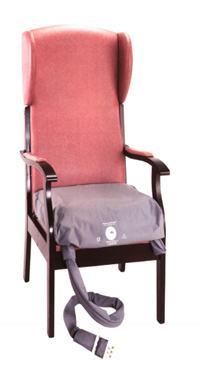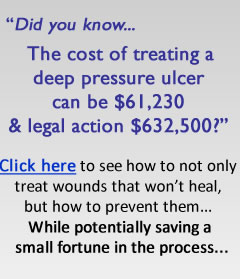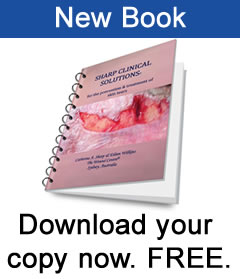Pressure ulcers; what causes them and what prevents them?
Unrelieved pressure over any part of the body for any period of time can cause pressure ulcers. That period of time is different for each patient. It can be a matter of minutes to hours but it is easy to understand.
Anyone who cannot reposition himself or herself; anyone who cannot roll from side to side in bed or get in and out of a bed or chair for example, is at risk of pressure ulcer development.
When somebody cannot move to change position this results in unrelieved pressure in the tissues and blood vessels that are sandwiched between the bony skeleton and a static surface such as a bed or chair. Immobility or decreased mobility is the only evidence-based risk factor for pressure ulcer development.
Patients with diabetes that cannot move themselves and who have no feeling in their feet because of peripheral neuropathy are at risk of heel pressure ulcers in particular, not only because of their immobility but because they may not be able to feel the pain of pressure, therefore may not change position.
The patient that can neither move nor communicate e.g. cannot speak following a stroke, cannot tell you about the pressure pain they feel in their buttocks when sitting for just a few minutes in a chair, is at risk.
Slide 1 Normal Body Reaction to the Effects of Gravity

The tissue (skin, fat, muscle, blood vessels etc.) between the ischial tuberosities (the bones in the buttocks) and the seat surface are compressed in a normal healthy person, like Fred and in sick patients, so that there is an extensive area of ischaemic (totally bloodless) tissue. Ischaemic tissue is not good for the body.
Messages go to the brain, which responds by making Fred move (usually subconsciously). THERE IS COMPLETE RELIEF OF PRESSURE, blood surges into the previously ischaemic tissue in the reactive hyperaemic response and any damage resulting from the ischaemia is repaired, in a healthy person.
Now the body rests on a different set of pressure points. A few minutes later this all happens again; Fred moves and there is reperfusion of the area of tissue previously under pressure. The alternate application and then removal of pressure to the tissue covering our bony prominences is as normal as expiration follows inspiration. But what happens to the sick patient who cannot move?
SLIDE 2 Repositioning Equipment.

SLIDE 3 The Viaclin ™ Alternating pressure air mattress (APAM)

There are a couple of wonderful mattresses that I recommend: the Nodec A™ and the Viaclin ™ for the majority of patients in hospital, the community and in nursing homes. A major advantage of the Viaclin ™ alternating pressure air mattress overlay is that it ties on top of the existing mattress.
There is no need for nurses to lift the existing mattress off the bed (an OH&S issue), to drag it down to a storage area (which many facilities do not have) in order to put a full APAM replacement on the bed.
If the patient is on an APAM there is no need for nurses to wake them up to carry out the traditional ‘2-hourly PAC’ regime to prevent pressure ulcers.You have to try to imagine it yourself – being woken from a deep sleep every night for months and years on end (remember having to wake up to breastfeed your babies – all the mothers reading this!!!!).
If the patient is asleep when you do your rounds they should be left to sleep. On the other hand if they are lying awake they can be repositioned. This helps with lung perfusion, joint mobility and provides a change of scene. If you work in the community or a nursing home your patients may be with you for months and years therefore they should not be woken from sleep to be repositioned. Sleep deprivation is harmful to normal metabolism. Nurse them on an APAM. Fewer episodes of repositioning patients also means fewer back injuries for nurses!!
Having an APAM is wonderful for patients cared for by family in their homes. NOBODY need lose sleep! I have met many elderly people who have been told, by health professionals, to reposition an equally elderly spouse every two hours in order to prevent pressure ulcers!! HOW HARD IS THAT? Neither gets any sleep. And when the patient does get a pressure ulcer the elderly spouse is blamed for it!!! The guilt suffered is impossible to imagine. If health professionals can’t prevent pressure ulcers how can we expect an elderly spouse to prevent them?
There are, of course exceptions to this idea of leaving patients to sleep. If the patient has a chest infection the physiotherapist may want the patient to be repositioned frequently during the period of illness.
There are contraindications for the use of APAM’s. Patients with unstable spinal fractures for example cannot be nursed on a moving surface. Decisions for care should always be multidisciplinary.
SLIDE 4 Checklist for high efficiency alternating pressure air mattresses.

With limited budgets, healthcare facilities need therapeutic equipment that performs as expected. The high output alternating air devices increase tissue perfusion beneath the bony prominences and prevent pressure ulcers and may heal established pressure ulcers. (I have certainly seen elderly, dying patients whose pressure ulcers have healed whilst on the Viaclin ™). I have NEVER known a patient to develop a pressure ulcer whilst nursed on a Viaclin ™.
SLIDE 5 Sideformers on the Viaclin ™.

Only high output compressors with air to spare can provide the luxury of side-formers. Side formers prevent the edge of the mattress from collapsing when nurses are trying to get the patient out of bed. Nurses have been known to really hurt their backs trying to hold up patients who slip unexpectedly off the edge of the bed. Sideformers can also prevent the patient getting stuck between the bed rails and the mattress.
SLIDE 6 Cardio-pulmonary resuscitation (CPR) pull.

In the event of a cardiac arrest it is important to not only be able to FIND the CPR pull (many are hidden under the mattress) but that once it is pulled the mattress deflates as quickly as possible. The Viaclin ™ CPR pull is easy to see and deflates quickly.

The added extra that I recommed is the Daycare Alternating Pressure Air Cushion. If the patient is at risk of Pressure Ulcers and they need an Alternating Pressure Air Mattress, then it makes sense to provide them with an equivalent when sitting out of bed.
One motor serves both the Alternating Pressure Air Mattress and the Alternating Pressure Air Cushion.

(I have not been paid by Pegasus to promote their products.)



It’s difficult to find well-informed people in this particular subject, but you seem like you know what you’re talking about!
Thanks
Valuable information. Lucky me I found your website unintentionally, and I am surprised why this accident didn’t came about earlier! I bookmarked it.
Nice post. I was checking continuously this blog and
I am inspired! Extremely helpful information specifically the closing part :
I deal with such information a lot. I was seeking this particular information for a long time.
Thank you and best of luck.
There is definately a lot to learn about this issue.
I love all of the points you have made.
whoah this blog is fantastic i really like reading your articles.
Keep up the good work! You realize, many individuals are hunting around for this info, you can aid them greatly.
Excellent post. I was checking constantly this blog and I’m impressed! Very helpful info specially the last part 🙂 I care for such information much. I was looking for this particular info for a very long time. Thank you and good luck.
Your mode of telling all in this paragraph is in fact fastidious, every one be able to
easily be aware of it, Thanks a lot.